Cooling Process Simulation
Visualizing Newton's Law of Cooling: How temperature changes over time based on the temperature difference with the surroundings
Example
Question:
A pan filled with hot food cools from \(94^\circ\mathrm{C}\) to \(86^\circ\mathrm{C}\) in 2 minutes when the room temperature is at \(20^\circ\mathrm{C}\). How long will it take to cool from \(71^\circ\mathrm{C}\) to \(69^\circ\mathrm{C}\)?
Solution:
The average temperature of \(94^\circ\mathrm{C}\) and \(86^\circ\mathrm{C}\) is \(90^\circ\mathrm{C}\), which is \(70^\circ\mathrm{C}\) above the room temperature. The pan cools \(8^\circ\mathrm{C}\) in 2 minutes.
Using Eq. (10.21):
\[
\frac{\text{Change in temperature}}{\text{Time}} = K \Delta T
\]
\[
\frac{8^\circ\mathrm{C}}{2\,\text{min}} = K(70^\circ\mathrm{C})
\]
For cooling from \(71^\circ\mathrm{C}\) to \(69^\circ\mathrm{C}\), the average temperature is \(70^\circ\mathrm{C}\), which is \(50^\circ\mathrm{C}\) above room temperature:
\[
\frac{2^\circ\mathrm{C}}{\text{Time}} = K(50^\circ\mathrm{C})
\]
Dividing,
\[
\frac{8^\circ\mathrm{C}/2}{2^\circ\mathrm{C}/\text{Time}} = \frac{K(70^\circ\mathrm{C})}{K(50^\circ\mathrm{C})}
\]
\[
\frac{4}{2^\circ\mathrm{C}/\text{Time}} = \frac{70}{50}
\]
Solving,
\[
\text{Time} = 0.7\,\text{min} = 42\,\text{s}
\]
Simulation Results
About Newton's Law of Cooling
Newton's Law of Cooling states that the rate of heat loss of a body is directly proportional to the difference in temperatures between the body and its surroundings. The law is often expressed as:
dT/dt = -k(T - Tₛ)
Where T is the temperature of the object, Tₛ is the surrounding temperature, and k is the cooling constant.
In the example problem, the pan cools from 94°C to 86°C in 2 minutes when the room temperature is 20°C. Using the formula, we can calculate that it will take 0.7 minutes (42 seconds) to cool from 71°C to 69°C.



